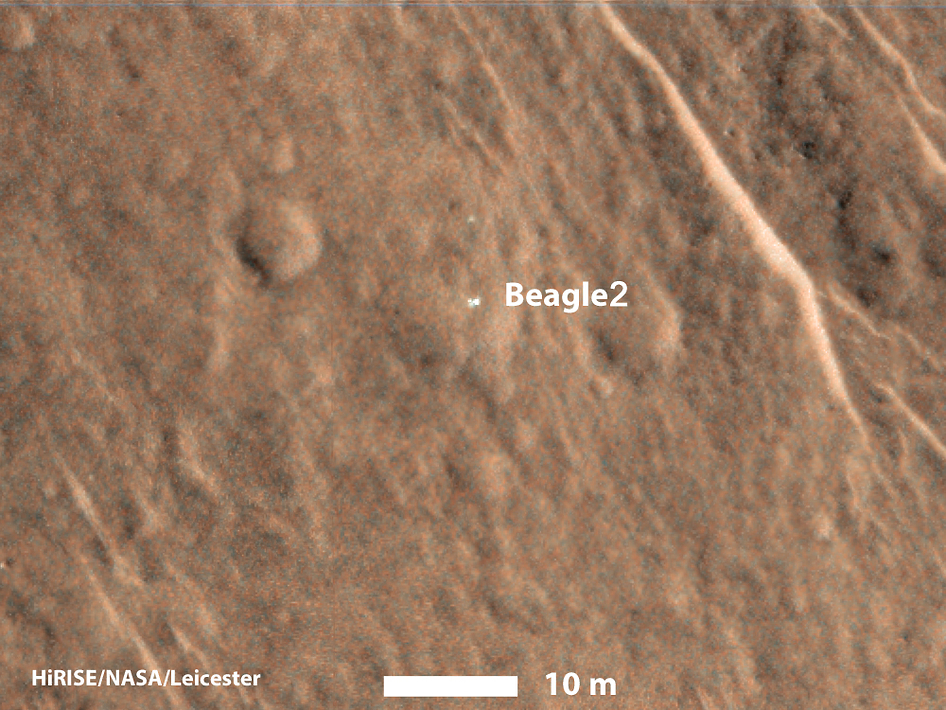
This annotated image from NASA’s Mars Reconnaissance Orbiter shows a bright feature interpreted as the United Kingdom’s Beagle 2 Lander, which was never heard from after its expected Dec. 25, 2003, landing. The image was taken by the orbiter’s HiRISE camera on Dec. 15, 2014. Credit: NASA/JPL-Caltech/Univ. of Arizona/University of Leicester
Update: See below new Pillinger Point panorama on Mars named in honor of the late Colin Pillinger, Beagle 2 PI
The mystery of the “long lost” British Beagle 2 Mars lander that vanished without a trace some 11 years ago, during its plummet to the Red Planet’s surface around Christmas 2003, has at last been solved.
The diminutive Beagle 2 has been found intact in high-resolution images taken by NASA’s Mars Reconnaissance Orbiter (MRO), after a grueling search that stretched over many years. It was loaded with an innovative science payload specifically designed to look for alien life forms.
The announcement of Beagle 2’s discovery was made at a press conference in London at the UK Space Agency on Jan. 16 by science team members and agency officials.
“I am delighted that Beagle 2 has finally been found on Mars,” said Mark Sims of the University of Leicester, U.K. He was an integral part of the Beagle 2 project from the start, leading the initial study phase, and was Beagle 2 mission manager.
“Every Christmas Day since 2003 I have wondered what happened to Beagle 2. My Christmas Day in 2003 alongside many others who worked on Beagle 2 was ruined by the disappointment of not receiving data from the surface of Mars. To be frank I had all but given up hope of ever knowing what happened to Beagle 2. The images show that we came so close to achieving the goal of science on Mars.”
“It was going to look for evidence of life on Mars and do world class science. It was way ahead of its time.”
The images from MRO’s HiRISE camera show that it clearly survived the impact of landing and touchdown and seems to be largely intact. Indeed several of its life-giving solar arrays unfurled, at least partially. But for some reason they apparently did not fully unfold and the communications gear also did not deploy, making it impossible for the British-built probe to phone home its status and data.
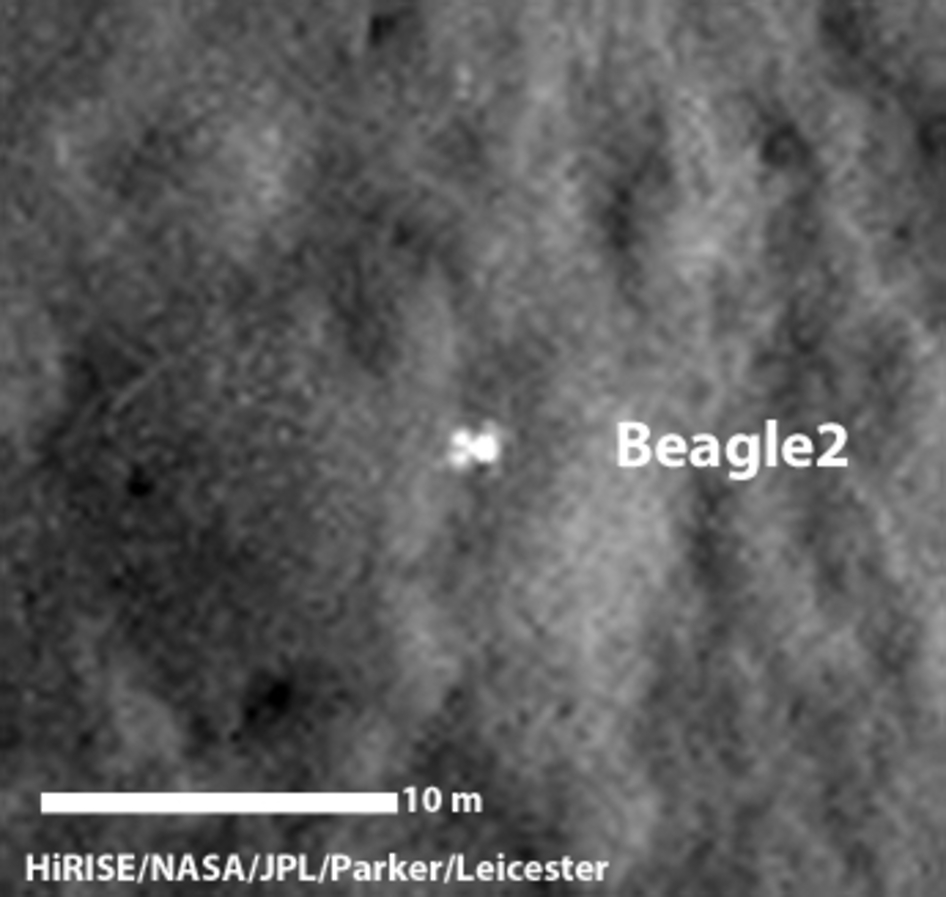
A configuration interpreted as the United Kingdom’s Beagle 2 Lander, with solar panels at least partially deployed, is indicated in this composite of two images from the High Resolution Imaging Science Experiment (HiRISE) camera on NASA’s Mars Reconnaissance Orbiter. Credit: NASA/JPL-Caltech/Univ. of Arizona/University of Leicester
The long-lost probe was detected in a set of three HiRISE (High Resolution Imaging Science Experiment) images—see above and below.
The initial finding was made in 2013 in images searched by a private citizen, Michael Croon of Trier, Germany, a former member of the European Space Agency’s Mars Express operations team at ESOC located in Darmstadt, Germany.
Subsequent images were commissioned and confirmed that the targets discovered are of the correct size, shape, color, and dispersion to be Beagle 2, according to a NASA statement.
Furthermore, it was found within 5 kilometers (3 miles) of the center of the expected landing area of Isidis Planitia, an ancient impact basin close to the Martian equator that formed about 3 to 4 billion years ago.
Beagle 2 flew to the Red Planet piggybacked on the European Space Agency’s (ESA) Mars Express orbiter, which was launched from Kazakhstan on June 2, 2003, and still operates very well to this day.
It was ejected from the orbiter on Dec. 19, 2003, and should have landed six days later on Christmas Day 2003 after a parachute- and airbag-assisted touchdown. But no signals were ever received, and many feared that it had crashed on impact.
With the new findings, Beagle 2 now counts as the first European built spacecraft to land on the Red Planet. ESA’s ExoMars program aims to dispatch new landers and rovers to Mars in 2016 and 2018 in collaboration with Russia.
“The history books need to be slightly rewritten to say that Beagle 2 did land on Christmas Day 2003,” said Sims.
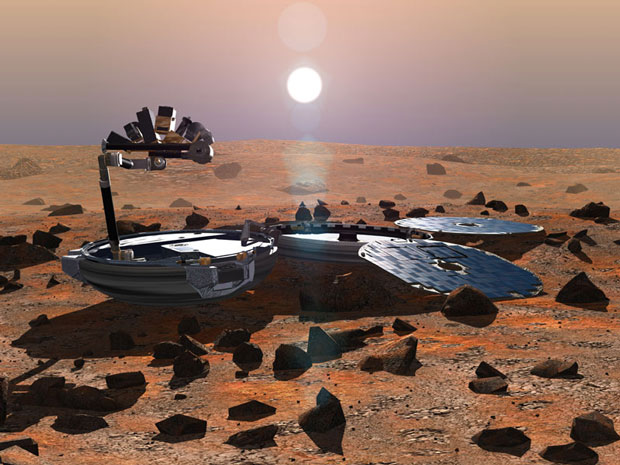
Finding the clam-shaped Beagle 2 has been difficult because of its small size of about 1 meter in diameter when folded up. After bouncing on the cushioning air bags and rolling to a touchdown, it was supposed to open up somewhat like a giant pocket watch and then fold open additional motorized solar panels like flower petals, exposing the science instruments and communications gear. Radio contact was never established, perhaps due to a faulty motor or a hard bump during landing.
“Beagle 2 is no longer lost. It seems we are no longer looking at a crash site,” said Dr David Parker, Chief Executive of the UK Space Agency.
“These images are consistent with Beagle 2 landing on Mars but only partially deploying.”
“The history of space exploration is marked by both success and failure.”
“This finding makes the case that Beagle 2 was more of a success than we previously knew and undoubtedly an important step in Europe’s continuing exploration of Mars.”
When fully unfurled the lander measured only about 1.6 x 1.9 meters (4 x 7 feet) across.
It had a landed mass of 33 kg and was loaded with the most ambitious science payload to systems mass ratio ever attempted, according to the team. The British probe was designed and developed by a combined team from academia and industry.
The Beagle 2 lander was built to search for signs of life on Mars, including organic molecules. It was named after HMS Beagle, Charles Darwin’s famed ship of exploration in the 1830s where he formulated the Theory of Evolution.
The project was the brainchild of and led by Prof. Colin Pillinger, a British planetary scientist at the Open University in Milton Keynes.
The primary mission phase was planned for an expected lifetime of 180 sols, or Martian days.
The discovery of the fate of Beagle 2 was tinged with sadness because Pillinger never knew it’s fate. He passed away at the age of 70 on May 7, 2014, due to a brain hemorrhage.
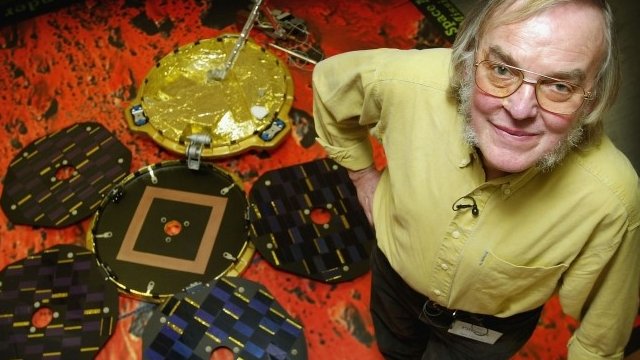
The eccentric Pillinger was well known by the British public and strived to engage and excite them about science.
“It was a great project and privilege to be involved. Colin enthused everybody,” said Sims. “I just find it sad that Colin passed away last May and unfortunately will never know how close Beagle 2 got to doing the world-class science that he and the rest of the team proposed.”
In an obituary by the BBC, Dr. Parker said that Prof. Pillinger had played a critical role in raising the profile of the British space program and had inspired “young people to dream big dreams.”
During his distinguished career Pillinger also analyzed lunar rock samples from NASA’s Apollo moon landing missions and worked on ESA’s Rosetta mission.
“It’s important to note that Colin’s contribution to planetary science goes back to working on Moon samples from Apollo, as well as his work on meteorites,” Dr. Parker told the BBC.
“Beagle 2 wasn’t a failure by any stretch of the imagination,” Sims said. “It trained a whole generation of engineers and scientists in Mars exploration. And it led to ExoMars which will drill for potential evidence of organics in 2019.”
The MRO HiRISE camera is the only imager at Mars with sufficient resolution to find the petite spacecraft.
“With a fully deployed Beagle 2 being less than a few meters across and a camera image scale of about 0.3 m (10 inches), detection is a very difficult and a painstaking task,” said the HiRISE team in a statement. That is right at the limit of detection of the HiRISE camera.
“This find shows that the Entry, Descent and Landing (EDL) sequence for Beagle 2 worked and the lander did successfully touchdown on Mars on Christmas Day 2003.”
It was discovered near the center of the landing ellipse at approximately 11.5 degrees north latitude, 90.4 degrees east latitude.
After the initial spacecraft detection by Michael Croon, additional HiRISE images were collected and analyzed by the Beagle 2 team at the University of Leicester, the HiRISE team, and NASA’s Jet Propulsion Laboratory (JPL), Pasadena, Calif.
“I’ve been looking over the objects in the images carefully, and I’m convinced that these are Beagle 2 hardware.” said JPL planetary geologist Tim Parker, who has assisted in the search and processed some of the images, in a statement.
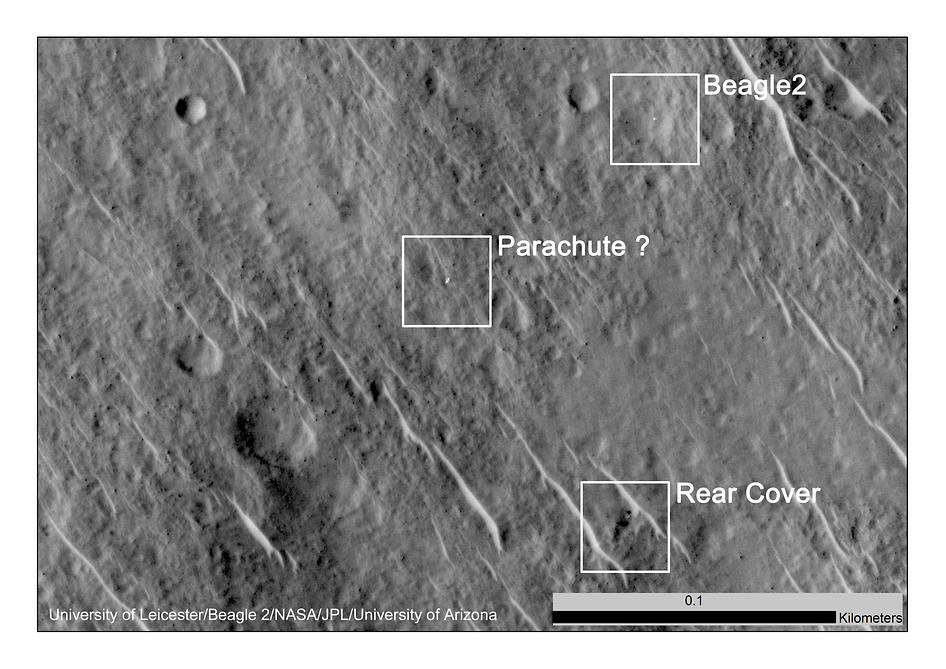
This annotated image shows where features seen in an observation by NASA’s Mars Reconnaissance Orbiter have been interpreted as hardware from the Dec. 25, 2003, arrival at Mars of the United Kingdom’s Beagle 2 Lander. The image was taken in 2014 by the orbiter’s HiRISE camera. Credit: NASA/JPL-Caltech/Univ. of Arizona/University of Leicester
Careful analysis of the images shows Beagle 2 to be in a partially deployed configuration along with what is believed to be the rear cover with its still attached pilot/drogue chute. The main parachute is close by, resting on Mars’ reddish surface.
Full deployment of the solar panels was required to expose the RF antenna as well as to transmit data and receive commands from Earth via orbiting Mars spacecraft, thus explaining why no signals were ever received, despite months of searching.
“The images are consistent with only partial deployment. Only one or more, and a maximum of three panels deployed,” explained Sims at the briefing.
“Without full deployment, there is no way we could have communicated with it as the radio frequency antenna was under the solar panels.”
“We intend to do further imaging and analysis.”
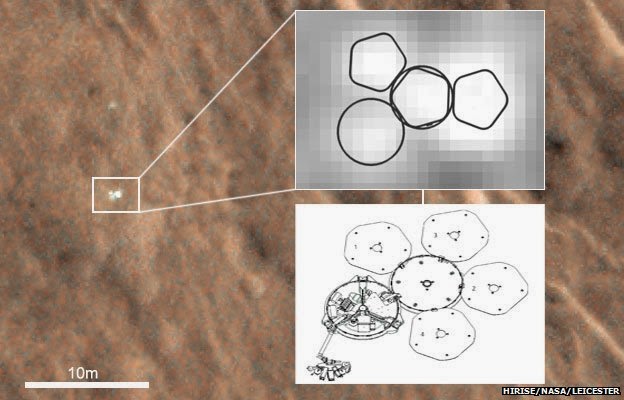
Mars Express and Beagle 2 were launched in 2003, the same year as NASA’s twin rovers Spirit and Opportunity, on their interplanetary voyages to help unlock the mysteries of Mars’ potential for supporting microbial life forms.
After Pillinger’s passing, the Mars Exploration Rover (MER) team named a noteworthy ridge at Endeavour Crater in his honor, where it was investigating in June 2014.
The region of aluminum-rich clay mineral outcrops was “named ‘Pillinger Point’ after Colin Pillinger the Principal Investigator for the [British] Beagle 2 Mars lander,” Prof. Ray Arvidson, Deputy Principal Investigator for the rover, told AmericaSpace.
“Pillinger Point” is a scientifically bountiful place possessing both clay mineral outcrops and mineral veins where “waters came up through the cracks,” Arvidson explained.

See above the spectacular panoramic view from Pillinger Point, where ancient water once flowed billions of year ago, created by Marco Di Lorenzo and Ken Kremer.
Since water is a prerequisite for life as we know it, this was a truly fitting tribute to name the then-current Opportunity exploration site Pillinger Point after Prof. Pillinger.
Following the recent arrival of NASA’s MAVEN orbiter and India’s first-ever interplanetary probe, the Mars Orbiter Mission (MOM), a record-breaking armada of seven Earth spacecraft are actively exploring the Red Planet. Mars continues to intrigue as our Solar System’s most Earth-like planet.
NASA’s rover Opportunity has just climbed to the summit of Cape Tribulation along Endeavour crater as she nears her astonishing 11th anniversary roving the Red Planet—detailed here and here.
NASA’s rover Curiosity is preparing to drill into her first rocket target of 2015—detailed here.
Stay tuned here for continuing developments regarding Earth’s “Missions to Mars” and throughout our Solar System!
Want to keep up-to-date with all things space? Be sure to “Like” AmericaSpace on Facebook and follow us on Twitter: @AmericaSpace
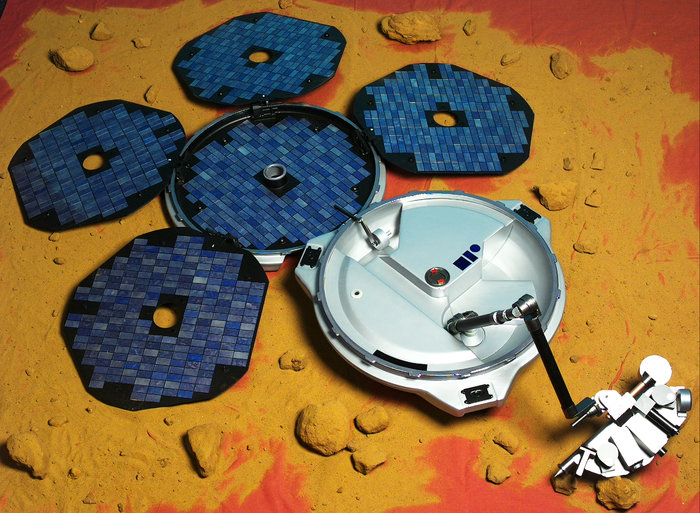
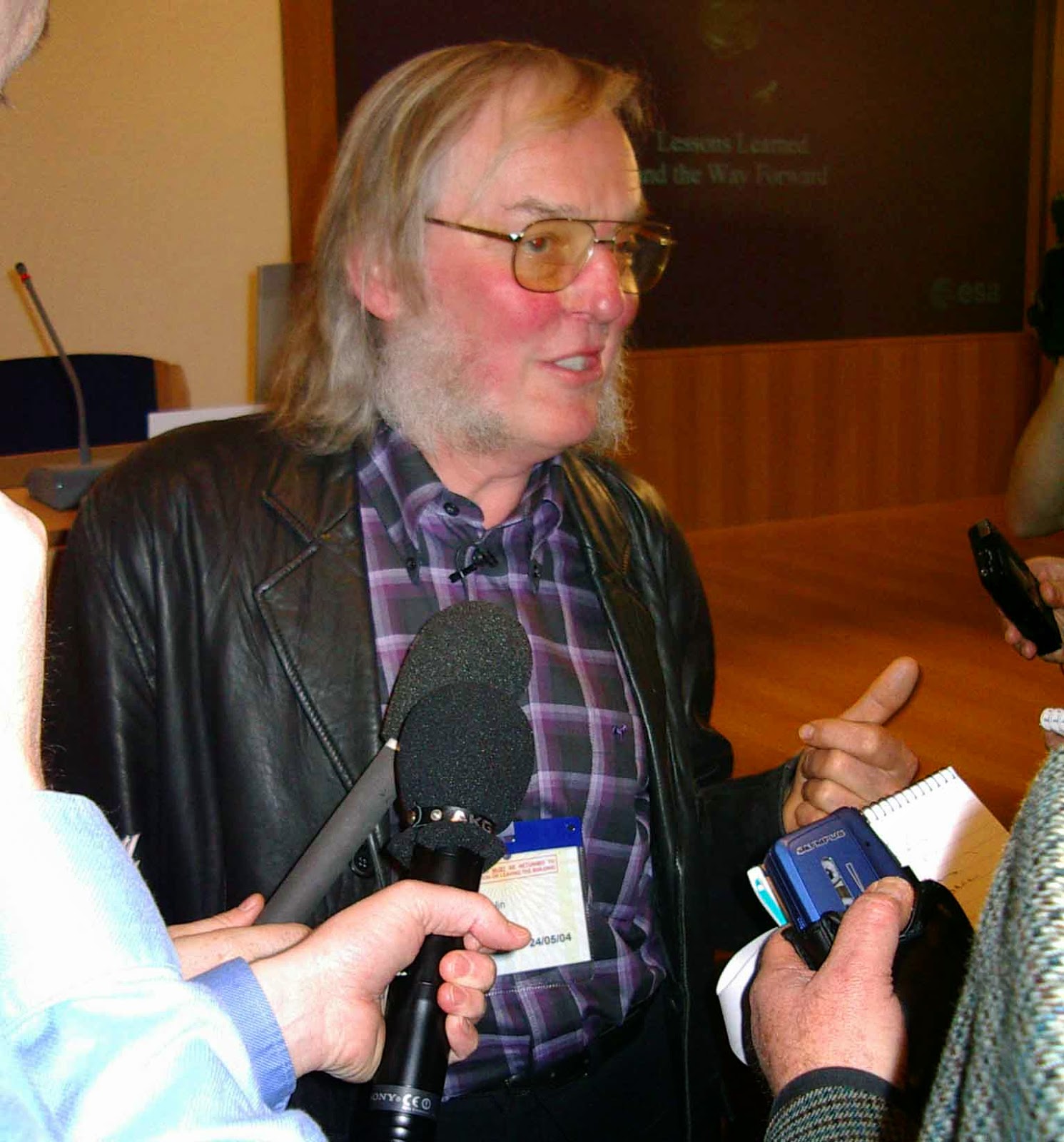




It would be interesting if the MRO can search and photograph other spacecraft such as the twin Viking landers, Phoenix and the Soviet Mars probes.
MRO has indeed already imaged Phoenix multiple times during and after the mission. also imaged the twin Viking landers. there is a MRO candidate image for Mars 3. thx
Thanks, Ken. Are those images available?
Yes they are all available on the MRO HiRISE website. Several from Phoenix and MSL can be found in my prior articles.